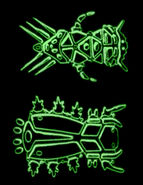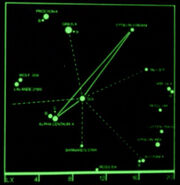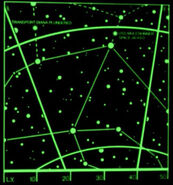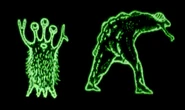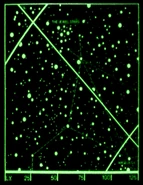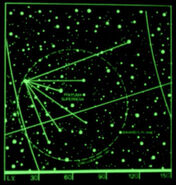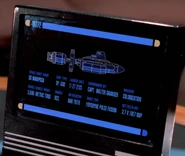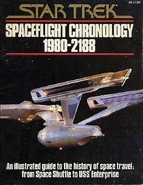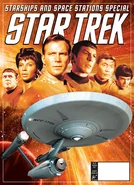m (→Background: typo) |
m (Robot: Automated text replacement (-\[[Hh]ttp://www.ex-astris-scientia.org/(.+?)\.htm] +{{eas|\1.htm}})) Tag: apiedit |
||
| (18 intermediate revisions by 4 users not shown) | |||
| Line 9: | Line 9: | ||
| ISBN = 0671790897 (both editions) |
| ISBN = 0671790897 (both editions) |
||
}} |
}} |
||
| − | The '''''Star Trek Spaceflight Chronology''''' is a reference book which catalogs mankind's technological endeavors into space, spanning the period from the launch of the first artificial satellite, ''[[Sputnik I]]'', to the events depicted in {{film|1}}, and the technology developed along the way. As such, it is a mixture of real-world events up until the [[space shuttle]] in 1980, and conjectural events afterwards, some of which depicted or referenced to during the run of ''[[Star Trek: The Original Series]]''. |
+ | The '''''Star Trek Spaceflight Chronology''''' is a [[reference book]] which catalogs mankind's technological endeavors into space, spanning the period from the launch of the first artificial satellite, ''[[Sputnik I]]'', to the events depicted in {{film|1}}, and the technology developed along the way. As such, it is a mixture of real-world events up until the [[space shuttle]] in 1980, and conjectural events afterwards, some of which were depicted or referenced to during the run of ''[[Star Trek: The Original Series]]''. |
| − | |||
| − | The book's timeline and illustrations are now considered by most to be outside of [[canon]], as they have been contradicted by information presented since its publication, both by real world events and events depicted or referred to in subsequent ''Star Trek'' productions, starting with [[TNG Season 1]]. |
||
| − | |||
| − | As the primary source available at the time, it was used as a model for [[FASA]]'s [[Star Trek: The Role Playing Game|role-playing games]] and several [[novels]] of the era. It was also used on occasion as reference by the writers of ''[[Star Trek: The Next Generation|The Next Generation]]'' in the very early stages of that series, before being abandoned as a source altogether. |
||
| − | |||
| − | In addition to newly-created starships found only within this volume, the chronology offered specifications for canonically established vessels such as the {{USS|Enterprise|XCV 330| (XCV 330)}} and [[DY-100 class]]. |
||
| − | |||
| ⚫ | |||
==Summary== |
==Summary== |
||
| Line 40: | Line 32: | ||
{{review}} |
{{review}} |
||
| − | ==Background== |
+ | ==Background information== |
| + | *The book was one of a total of sixteen titles, both [[novels]] and reference books, that were intended to coincide as a promotional tie-in with the premiere of ''The Motion Picture'' on 7 December 1979. (''Playboy'' magazine, January 1980, p. 310) However, due to the film's mixed reception, only about half of these, including this one, were ultimately released. |
||
| − | When it was published, ''The Spaceflight Chronology'' was only the second officially-licensed reference book intended for publication to the general public that delved into the history of the ''Star Trek'' universe from an in-universe perspective (the first one being ''[[Star Trek Star Fleet Technical Manual]]'') and the first chronology. Due to its very nature, it is doubtful that it was ever, even behind the scenes, considered "canon" (for example, while not known for sure at the time, the commissioning of the {{ShipClass|Constitution}} was projected in 2188 in the book, missing the point by about sixty years, as established since then). |
||
| ⚫ | |||
| + | *At the time this book was published, ''The Spaceflight Chronology'' was the second officially licensed reference book, intended for publication to the general public, that delved into the history of the ''Star Trek'' universe from an in-universe perspective. The first one being ''[[Star Trek Star Fleet Technical Manual]]''. This was also the first Star Trek chronology. As it often happens, the exact dating and several details of many events in the timeline have become outdated by new [[canon]] information introduced in subsequent ''Star Trek'' productions, starting with ''[[Star Trek: The Next Generation]]''{{'}}s [[TNG Season 1|first season]] in 1987. Yet, as one of only two primary sources available at the time, it was used as a model for [[FASA]]'s [[Star Trek: The Role Playing Game|role-playing games]] and several [[novels]] of the era. The book was also used on occasion as reference source by ''The Next Generation'' staff in the early stages of the series. |
||
| + | *In addition to several newly invented starships found only within this volume, the chronology offered specifications, depictions and further development history information for several canonically established vessels such as the original and [[refit]]ted {{class|Constitution}}, the [[class F shuttlecraft]], the [[DY-100 class]], the [[DY-500 class]], the [[Earth-Saturn probe]], the {{USS|Enterprise|XCV 330| (XCV 330)}}, the {{USS|Horizon}} and the {{USS|Valiant|23rd century}}. Also, other historical information provided during the original run of [[TOS]] was incorporated into the book. Information from ''[[Star Trek: The Animated Series]]'' was mostly ignored. The two exceptions were information about the [[Terra 10]] colony ship mentioned in the {{TAS|The Terratin Incident}} and the [[Bonaventure (10281NCC)|''Bonaventure'']] from {{TAS|The Time Trap}}. The depiction of the ''Bonaventure'' from the animated series however was utterly disregarded and a brand-new, more "archaic" looking design was introduced instead. |
||
| ⚫ | *In 2011, authors [[Dayton Ward]] and [[Kevin Dilmore]] paid homage to ''The Spaceflight Chronology'' as they attempted to update the ''Chronology'' with insight garnered since its publications. They wrote a ten-page article that consisted of sections written in the style of ''The Spaceflight Chronology'' which incorporated updated material, canonically established in the ''Star Trek'' franchise since then. Their homage has been published in {{STM|162}}, pages 62-73. |
||
| + | |||
| + | ===Production use=== |
||
| + | Several graphics from the reference book were used in canon productions. Starcharts, depictions of alien lifeforms and starship designs appeared in ''Star Trek: The Next Generation'' as computer readouts in such episodes as {{TNG|The Naked Now|The Last Outpost|Datalore|Conspiracy}}. {{eas|observations/datalore.htm}} |
||
| + | <gallery> |
||
| − | Though information provided during the original run of [[TOS]] has been incorporated into the book, none provided during the run of ''[[Star Trek: The Animated Series]]'' (most notably the episode {{e|The Time Trap}}) has, as this series was considered non-canon at the time. This was especially evident when it came to the treatise on the {{ShipType|Bonaventure}}. The depiction in the animated series was utterly disregarded and a brand-new, more "archaic" looking design was introduced instead. Apparently, later ''Star Trek'' production staffers came to agree with the authors' take on the revised design when a [[model|display model]] of the ''[[Bonaventure (C1-21)|Bonaventure]]'' was featured in the ''[[Star Trek: Deep Space Nine]]'' episodes {{e|The Nagus}}, {{e|In the Hands of the Prophets}}, and {{e|Cardassians}}. That model carried more than a passing resemblance to the one presented in the book. |
||
| + | File:Beetles on viewscreen.jpg|[[Mars|Martian]] [[Martian insect|insect]] fossils, (page 46) |
||
| + | File:Spaceflight Chronology starchart 1.jpg|A starchart with the locations of [[Sol]], [[Barnard's Star]], [[Alpha Centauri]] A, B, [[Proxima Centauri|C]], [[Lalande 21185]], [[Wolf 359]], [[Procyon]] A, B, [[Sirius]] A, B, [[Epsilon Eridani]], [[Tau Ceti]], [[Groombridge 34]] A, B, [[Ross 248]], [[Luyten 789-6]], [[Epsilon Indi]], [[61 Cygni]] A, B and [[Ross 154]], (page 77) |
||
| + | File:Spaceflight Chronology starchart 2.jpg|A starchart with the locations marked where the [[transport]] ''[[Diana]]'' was plundered and the {{USS|Muleskinner}} was spacejacked, (page 95) |
||
| + | File:Spaceflight Chronology alien creatures.jpg|Aliens encountered by [[Human]]s on [[Rigel IV]], (page 96) |
||
| + | File:Spaceflight Chronology starchart 3.jpg|A starchart with the location where the {{USS|Greyhound}} encountered an [[extra galactic probe]], (page 115) |
||
| + | File:Spaceflight Chronology starchart 4.jpg|A starchart with the location of the [[Jewel stars]] and [[Argelius II]], (page 133) |
||
| + | File:Unnamed ship 2, Conspiracy.jpg|Two ''Provider''-class starships docked together, (page 150) |
||
| + | File:Spaceflight Chronology starchart 5.jpg|A starchart with the location of the [[Phi Puma]] [[supernova]] and it's [[concussion ring]] in [[2165]] and the [[Bayard's Planet]], (page 151) |
||
| + | </gallery> |
||
| + | Another depiction that influenced canon was the depiction of an uprated [[21st century]] [[DY-500 class]] [[sublight]] ship on page 37. In the second season episode {{TNG|Up The Long Ladder}}, the depiction of a canonical [[22nd century]] DY-500 class [[starship]] was heavily influenced by this original design, introduced in ''The Spaceflight Chronology''. |
||
| − | While ''The Spaceflight Chronology'' paid homage to the references provided in TOS, reciprocally, almost none of their creations were embedded into official ''Star Trek'' lore. Apart from the reference to the ''Bonaventure'', the only other reference that made it into canon was the subtle reference in {{e|Up The Long Ladder}}, where an [[okudagram]] depicting the {{SS|Mariposa}}, a member of the {{ShipClass|DY-500}}, was featured. While referenced to in ''[[Star Trek: The Next Generation - The Continuing Mission]]'' (page 85) as being a homage to the [[DY-100 class]] of the original series, the DY-500 class designation had been already used in ''The Spaceflight Chronology'', and Okuda's interpretation was such a very close approximation of the one depicted in that book, that a homage to that work should be considered the most likely explanation. |
||
| + | <gallery> |
||
| ⚫ | In 2011, authors [[Dayton Ward]] and [[Kevin Dilmore]] paid |
||
| + | File:DY-500 original configuration.jpg|21st century DY-500 class (''The Spaceflight Chronology'', page 37) |
||
| + | File:SS Mariposa.jpg|22nd century DY-500 class ("Up The Long Ladder" display graphic) |
||
| + | </gallery> |
||
| − | == |
+ | ===Cover gallery=== |
<gallery> |
<gallery> |
||
File:Star Trek Spaceflight Chronology (UK).jpg|Cover abridged UK-edtion |
File:Star Trek Spaceflight Chronology (UK).jpg|Cover abridged UK-edtion |
||
Revision as of 19:36, 21 March 2015
Template:Realworld The Star Trek Spaceflight Chronology is a reference book which catalogs mankind's technological endeavors into space, spanning the period from the launch of the first artificial satellite, Sputnik I, to the events depicted in Star Trek: The Motion Picture, and the technology developed along the way. As such, it is a mixture of real-world events up until the space shuttle in 1980, and conjectural events afterwards, some of which were depicted or referenced to during the run of Star Trek: The Original Series.
Summary
- From the book jacket (US)
- The stars beckon... man responds! The human adventure is just beginning!
- The publication of this book initiates an exciting and necessary project: to provide Star Fleet Academy Cadets with a concise illustrated history of their home planets, spaceflight, evolution and development.
- So, Cadets from Earth, welcome to the history of your planet's two and a half illustrious centuries in space – years filled with extraordinary achievement, darkened by great tragedy, marked by countless marvels and perils. The future will be made by you who read this chronology.
- Learn the past to make the future.
- Live long and prosper!
- From the book jacket (UK)
- The Spaceflight Chronology - abridged from a much greater work - has been compiled to provide Star Fleet Academy Cadets with a concise, illustrated history of their home planet's spaceflight evolution and technical development. It covers two centuries, starting with the first Space Shuttle flights in 1980 and ending with the heavy cruiser Constitution class star ships in 2188. More than 100 spacecrafts are featured; these include the Icarus which, in 2048, made Earth's first contact with the Alpha Centauri civilization and the King Charles, the most luxurious starliner ever built.
- Henceforth, freshman Cadets of planet Earth and eventually freshman Cadets from Vulcan, Rigel, Alpha Centauri, Tellar and Andor, should include Spaceflight Chronology on their essential reading list.
- UNITED FEDERATION OF PLANETS
- Excerpts of copyrighted sources are included for review purposes only, without any intention of infringement.
Background information
- The book was one of a total of sixteen titles, both novels and reference books, that were intended to coincide as a promotional tie-in with the premiere of The Motion Picture on 7 December 1979. (Playboy magazine, January 1980, p. 310) However, due to the film's mixed reception, only about half of these, including this one, were ultimately released.
- An abridged UK edition, entitled Star Trek Spaceflight Chronology 1980-2188 was published the same year by publishing house Phoebus.
- At the time this book was published, The Spaceflight Chronology was the second officially licensed reference book, intended for publication to the general public, that delved into the history of the Star Trek universe from an in-universe perspective. The first one being Star Trek Star Fleet Technical Manual. This was also the first Star Trek chronology. As it often happens, the exact dating and several details of many events in the timeline have become outdated by new canon information introduced in subsequent Star Trek productions, starting with Star Trek: The Next Generation's first season in 1987. Yet, as one of only two primary sources available at the time, it was used as a model for FASA's role-playing games and several novels of the era. The book was also used on occasion as reference source by The Next Generation staff in the early stages of the series.
- In addition to several newly invented starships found only within this volume, the chronology offered specifications, depictions and further development history information for several canonically established vessels such as the original and refitted Constitution-class, the class F shuttlecraft, the DY-100 class, the DY-500 class, the Earth-Saturn probe, the USS Enterprise (XCV 330), the USS Horizon and the USS Valiant. Also, other historical information provided during the original run of TOS was incorporated into the book. Information from Star Trek: The Animated Series was mostly ignored. The two exceptions were information about the Terra 10 colony ship mentioned in the TAS: "The Terratin Incident" and the Bonaventure from TAS: "The Time Trap". The depiction of the Bonaventure from the animated series however was utterly disregarded and a brand-new, more "archaic" looking design was introduced instead.
- In 2011, authors Dayton Ward and Kevin Dilmore paid homage to The Spaceflight Chronology as they attempted to update the Chronology with insight garnered since its publications. They wrote a ten-page article that consisted of sections written in the style of The Spaceflight Chronology which incorporated updated material, canonically established in the Star Trek franchise since then. Their homage has been published in Star Trek Magazine issue 162, pages 62-73.
Production use
Several graphics from the reference book were used in canon productions. Starcharts, depictions of alien lifeforms and starship designs appeared in Star Trek: The Next Generation as computer readouts in such episodes as TNG: "The Naked Now", "The Last Outpost", "Datalore", "Conspiracy". [1]
Another depiction that influenced canon was the depiction of an uprated 21st century DY-500 class sublight ship on page 37. In the second season episode TNG: "Up The Long Ladder", the depiction of a canonical 22nd century DY-500 class starship was heavily influenced by this original design, introduced in The Spaceflight Chronology.
Cover gallery
External link
- Template:NCwiki-title

